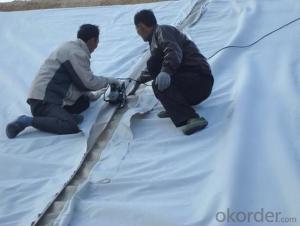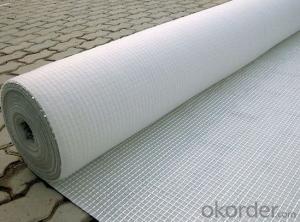Geotextil Negro Filament Geotextile, Non Woven Spunbond Needle Punch Geotextile
- Loading Port:
- Tianjin
- Payment Terms:
- TT OR LC
- Min Order Qty:
- 2000 m²
- Supply Capability:
- 900000 m²/month
OKorder Service Pledge
OKorder Financial Service
You Might Also Like
Product Description
Filament Geotextiles are permeable nonwoven fabrics used to separate,filter,reinforce, protect or drainage.Geotextiles allow filtration or separation of granular layers in roads and rail applications,used to protect membranes in landfill applications,used in coastal defence applications and used in landscaping to protect surfaces and structures from weeds and root growth.
Filament Geotextiles are available as woven and non-woven .As liner protection, against physical damage, the non wovens are normally the answer.They are made up of fibers of polyester or polypropylene in random directions and punched together by needles during the manufacturing process.Geotextiles are commonly used to separate layers like clay and drainage and to protect liner from damage.

Product Details

Features:
Engineered to provide high strength and high elongation at break to ensure excellent resistance to damage during construction
Manufactured from high tenacity UV stabilised virgin polypropylene or polyester fibers which have been heavily drawn to ensure excellent long term durability in all soil types.
Manufactured using a randomly orientated web to provide completely isotropic properties,ensuring that high strength is not limited to a single direction.
Excellent uniformity with high permeability and low pore size for soil filtration.
Supplied to a maximum width of 8.0 meters,ensuring minimum waste over large construction areas.
100% polypropylene or polyester staple fibers ,needle punched and random network formation.
UV and rot resistant and biological degradation resistant.

Majority Process:

Specific Data:
cItem | Area weight | Tensile Strength | Elongation | shrinkage | Roll Size | ||
MD | CMD | MD | CMD | ||||
Unit | G/M2 | N/125px | % | % | m x m | ||
Specification | 120 | ≥350 | ≥260 | 23 | 28 | <2.0< span=""> | 1.02x1700 |
140 | ≥380 | ≥300 | 25 | 30 | <1.0< span=""> | 1.01x1500 | |
150 | ≥500 | ≥330 | 28 | 35 | <1.0< span=""> | 1.01x1500 | |
160 | ≥550 | ≥350 | 30 | 35 | <1.0< span=""> | 1.01x1400 | |
180 | ≥600 | ≥450 | 30 | 35 | <1.0< span=""> | 1.01x1200 | |
200 | ≥750 | ≥450 | 30 | 35 | <1.0< span=""> | 1.01x1100 | |
220 | ≥800 | ≥500 | 30 | 35 | <1.0< span=""> | 1.01x1000 | |
250 | ≥950 | ≥600 | 35 | 40 | <1.0< span=""> | 1.01x800 | |
FAQ:
1. How to order your geotextile?
a). Tensile strength in warp & weft direction
b). gram per meter
c). Width and length
d). Quantity
2. Payment term .
a) TT
b) LC AT SIGHT
3. Delivery time
a) 19-25 days after received your deposit .
4. What is MOQ ?
a) 2000 m2 as MOQ , we can also produce sample for you .
- Q: What are the considerations for geotextile selection in railroad projects?
- There are several key considerations for geotextile selection in railroad projects. Firstly, the geotextile must have sufficient strength and durability to withstand the heavy loads and constant vibrations associated with train traffic. Additionally, it should have good filtration properties to prevent the migration of fine particles into the subgrade, which could lead to instability and settlement issues. The geotextile should also be resistant to degradation from environmental factors such as UV exposure and chemical exposure from ballast materials. Finally, the geotextile should be easy to install and maintain, ensuring a cost-effective and efficient solution for the railroad project.
- Q: How do geotextiles help in preventing erosion around culverts?
- Geotextiles help in preventing erosion around culverts by acting as a barrier between the soil and water flow. They provide stability and reinforcement to the soil, preventing it from being washed away. Additionally, geotextiles help filter out sediment and prevent clogging of the culvert, ensuring proper water flow and reducing the risk of erosion.
- Q: How do geotextiles help with soil stabilization in steep slopes?
- Geotextiles help with soil stabilization in steep slopes by acting as a barrier that prevents erosion and soil movement. They provide reinforcement to the soil, increasing its strength and stability, while still allowing water to drain through. This prevents the loss of soil particles, helps retain moisture, and promotes healthy plant growth, ultimately reducing the risk of landslides and erosion in steep slope areas.
- Q: What are the advantages of using geotextiles in road construction?
- There are several advantages of using geotextiles in road construction. Firstly, geotextiles act as a separator, preventing the mixing of different layers of soil and aggregate, which helps in maintaining the integrity and stability of the road. Secondly, geotextiles enhance the load-bearing capacity of the road by distributing the load from heavy traffic more evenly, reducing the risk of deformation and rutting. Additionally, geotextiles can improve drainage capabilities, allowing water to drain more efficiently, preventing water buildup and potential damage to the road structure. Moreover, geotextiles can reduce the amount of fine particles migrating from the subgrade to the pavement layers, thus enhancing the overall durability and lifespan of the road. Lastly, using geotextiles can also reduce construction time and costs by reducing the need for excessive excavation and replacement of poor-quality soils.
- Q: How are geotextiles used in erosion control?
- Geotextiles are used in erosion control by being placed on the soil surface or within the soil profile to prevent or reduce soil erosion. They act as a barrier, allowing water to pass through while retaining soil particles. This helps in stabilizing slopes, preventing sediment runoff, and promoting vegetation growth.
- Q: Where are geotextiles used?
- Geotextiles are used in various civil engineering and environmental applications, including road construction, erosion control, drainage systems, landfills, and retaining walls.
- Q: How do geotextiles improve the performance of geogrids?
- Geotextiles improve the performance of geogrids by acting as a separator, preventing the mixing of different soil layers and allowing for better load distribution. They also provide filtration, allowing water to pass through while preventing the migration of fine particles, which helps in maintaining the stability and longevity of the geogrid. Additionally, geotextiles act as a cushioning layer, reducing the potential for damage to the geogrid and enhancing its overall effectiveness in reinforcement applications.
- Q: How do geotextiles help in separating different soil layers?
- Geotextiles help in separating different soil layers by acting as a barrier between them, preventing the intermixing of soil particles. This separation allows for better drainage and filtration, as well as reducing the risk of soil erosion and maintaining the stability of the soil structure.
- Q: How do geotextiles contribute to the performance of geogrid-reinforced slopes?
- Geotextiles contribute to the performance of geogrid-reinforced slopes by providing separation, filtration, and reinforcement. They act as a barrier between the soil layers, preventing the mixing of different materials and maintaining the integrity of the slope. Geotextiles also help with filtration by allowing water to pass through while preventing the movement of fine particles, which can clog the geogrid. Additionally, geotextiles enhance the reinforcement provided by geogrids by distributing the load and reducing localized stress concentrations, improving the overall stability and performance of the slopes.
- Q: What are the environmental considerations of geotextiles?
- Geotextiles have several environmental considerations, both positive and negative. On the positive side, geotextiles can help prevent soil erosion, reduce sedimentation in water bodies, and improve the stability of slopes and embankments, ultimately leading to the preservation of natural habitats. Additionally, geotextiles are often made from recycled materials, such as plastic bottles, which can help reduce waste and promote sustainability. However, there are also potential negative environmental impacts associated with geotextiles. The production and disposal of geotextiles can contribute to pollution, particularly if non-recycled materials are used. Additionally, if not properly installed or maintained, geotextiles can cause unintended consequences, such as altering natural drainage patterns or obstructing the movement of wildlife. Therefore, it is important to carefully assess the environmental implications of using geotextiles and ensure proper installation, maintenance, and disposal practices to mitigate any potential negative impacts.
Send your message to us
Geotextil Negro Filament Geotextile, Non Woven Spunbond Needle Punch Geotextile
- Loading Port:
- Tianjin
- Payment Terms:
- TT OR LC
- Min Order Qty:
- 2000 m²
- Supply Capability:
- 900000 m²/month
OKorder Service Pledge
OKorder Financial Service
Similar products
Hot products
Hot Searches
Related keywords






























